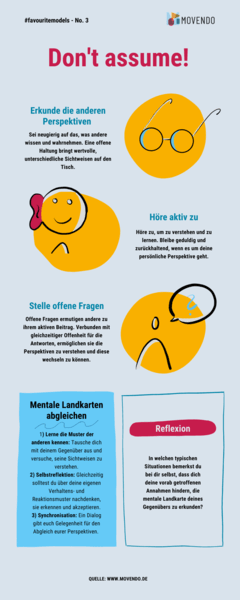Created by Katrin Aust
#favouritemodel No. 3 – Don’t assume

“Making assumptions” is one of the biggest stumbling blocks in communication and therefore also in the relationship between managers and their employees and colleagues. “Assuming” something instead of actually asking and finding out about it harbors the danger that I will impute my own image, understanding and knowledge to the other person and thus easily overlook the fact that differences actually exist.
Different information, different interpretations, different points of view. We learn very early on in our journey to reproduce knowledge and show that we are familiar with a topic. However, with an open attitude in which we do not make any assumptions, the first step is more about finding out what the other person’s perspective is, what they know or think. This is an attitude that requires a little practice.
So if I make it a habit to actually find out what exactly my counterpart perceives and interprets, sees and knows, then I come much closer to a common mental map, a comparison of the respective ideas or levels of knowledge. In our idea of cooperation, it is essential to explore and understand the other person’s perspectives.
In his book “Seven Ways to Effectiveness”, S. Covey talks about “first understanding, then being understood”. This is exactly what it’s all about when I always assume that different perspectives exist as a basic principle on the one hand and want to bring the mental maps together on the other.
An understandable challenge at this point is the time investment required to ask questions, listen and understand. It takes a bit of practice to put aside your own views, especially as a manager, and be open to the information provided by the person you are talking to. In the best case scenario, I get into the habit of asking open questions and actively listening in order to learn and understand as much as possible. I signal my interest by summarizing what I have heard and asking comprehension questions.
Interlocutors whom I meet with interest and openness feel that they are taken seriously, heard and can therefore contribute their perspective. The wonderful side effect once I have got into the habit of this approach is in most cases a very trusting interaction in which my colleagues and employees experience the clear advantage of “don’t assume” and at best also make it a habit. Asking open questions and being open to the answers means being able to understand and change perspectives. And I wouldn’t want to be without any of this in a working environment.
How does my #favoritemodel help you?
If you realize in a conversation that you have already described your point of view several times, but somehow it doesn’t seem to be getting through, then it’s usually high time to change perspectives and find out how the other person sees a certain situation.
Instead of repeating your opinion or view even more clearly or perhaps even louder, it is always worth listening first.
As a manager in particular, this is a so-called “SuperPower” and “SuperDuty” at the same time. One of the core tasks here is to listen to the knowledge and/or opinions of your employees, collect them and then, ideally, make them transparent for everyone. And this actually works primarily by first listening to the others and encouraging them to contribute by asking open questions.

Author

Katrin Aust
Consultant




